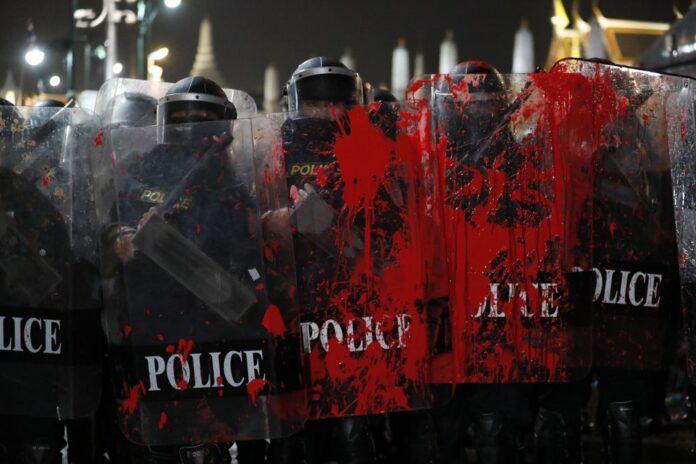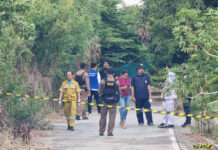
The video I took for Khaosod English of a group of police dragging and then brutally beating a defenseless man as they dispersed the monarchy-reform demonstrators went viral in no time.
After over three million views and 90,000 retweets on Twitter, the social media giant as well as Facebook classified the content as “sensitive”. The administrators of Twitter and Facebook couldn’t bear watching it and warn my followers and friends if they truly wanted to watch a 26-second video clip of police brutality.
When I ran into a long-time police contact who handled political protests a few days after that, he asked me how I would assess and score the police’s performance that night. I said the police were handling well until the last chapter when they went berserk.
ผู้ชุมนุมถูกตีและจับโดยตำรวจ #ป
Demonstrator beaten and arrested by police. #Thailand #ม็อบ13กุมภา pic.twitter.com/ZEOCUefPUV— Pravit Rojanaphruk (@PravitR) February 13, 2021
I saw three defenseless men beaten again and again with my own eyes and managed to capture it showing the police “in action” while my colleague Tappanai Boonnadit handled the Facebook Live camera. Crowd-control police apparently could not control their own emotions.
It’s not the police’s job to meet out instant punishment, or vendetta. That’s for the judges to decide.
There’s no denying that for half an hour, a group of 20 diehard protesters refused to quit after their leaders called it a night after 8.30pm and kept hurling bottles, both plastic and glass, bricks, home-made explosives and smoke bombs at the anti-riot police line. Police must have been angry but they were supposed to be professional about their job.
“This is unprofessional and I’m afraid it’s the police who screw up in the end,” I told my police contact who normally carries out his duty with relative calm, tact and knows all the anti-government-cum-monarchy-reform leaders.
At least of those beaten, Purapon Wongchiak, a medic volunteer medic who I saw beaten and unconscious before being arrested said on Wednesday he will file charges against police for use of excessive force.
Then there’s the mysterious men, around 40 of them, forming two lines just behind the anti-riot police line that night. None of them was wearing any uniforms or wearing any ID tag. They all wear military-style buzz cuts, however.
Who are they? Who deployed them? Why are they not in uniform as would expect under international rules of engagement?
Their sudden appearance was exacerbated by the fact that both police and military denied any knowledge of these mysterious men.
When I rang police spokesman Pol Maj Gen Yingyot Thepchamnong on Wednesday, he initially denied their existence. I told him I have taken photos, captured them on Facebook Live and I’m sure some news agency must have gotten it as well. The police spokesman then asked for 20 minutes to find out before telling me on the phone police had no clue who these men were.
“Those 30, 40 people who assembled, I have no idea either which group they belonged to,” Yingyot said. “But we are investigating.”
Meanwhile, Defense Ministry spokesman Maj Gen Kongcheep Tantravacheep flatly denied the armed forces had anything to do with it when I rang him on the same day. “We are not related to them at all. You have to ask the police,” Kongcheep said.
I rang the Defense Ministry spokesman because the Defense Ministry and Grand Palace are within a 150 meters distance from the police line.
Again, my police contact was there on that night working. He also said he didn’t know who they were despite the fact that he always played a prominent role at the protest.
Amazing Thailand!
But that’s not the end of the police’s amazing mishandling and abuses.
On that night, police kept announcing to reporters and photographers on the ground to keep recording the footage of angry protesters hurling bricks, bottles and other objects at the officers.
“Members of the press, please record it so we can use it as evidence,” the voice from the main loud-speaker van could be repeatedly heard.
However, when it came to the police’s crackdown time, journalists were “ordered” to stay away and physically kept behind the police line for “safety reasons”. This prevented most from getting close to the brutal beatings.
Tappanai and I were among the very few who were able to evade the police blockade in time.
“I didn’t see what was happening in the frontline. All I could see was there were clouds of smoke behind the police and I heard several bangs. I was only let go when the police managed to take control of the situation,” Sirote Klampaiboon, a popular newsman at Voice TV, told Tappanai on Thursday.
Sirote told me when I met him on Friday that he and about a dozen other journalists were encircled by police and prevented from doing their job. “They threatened to arrest us if we tried to get out of the circle surrounded by police. It lasted for half an hour until the police operation was over,” he recalled.
This is nothing short of censorship, a violation of press freedom. Various reporter associations should express concerns. Journalists should also remind themselves to be critical of both sides and not take orders from the police, or be fooled by them.
Without the evidence, still photographs and videos, captured by some remaining journalists, we would not have known for certain that Thai police unleashed a wave of senseless brutality against civilians and allowed an unacceptable practice of deploying a group of mysterious men in civilian clothes within the police line.
Yet, despite these graphic evidence, the flat denial that either excessive force was used or police had any knowledge of the mysterious men doesn’t bode well for future protests and confrontations.
A human rights lawyer contacted me earlier this week, telling me some of the people beaten by police want me as a witness for their lawsuits. This I am more than happy to make the truth apparent for it is my job as a journalist.











































